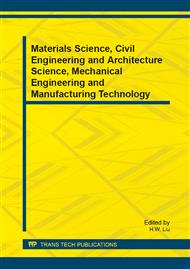[1]
Lubliner J, Oliver J, Oller S, et al. A Plastic-Damage Model for Concrete[J]. International Journal of Solids and Structures, 1989, 26(3): 299-326.
DOI: 10.1016/0020-7683(89)90050-4
Google Scholar
[2]
Lee J, Fenves G L., Plastic-Damage Model for Cyclic Loading of Concrete Structures[J]. Journal of Engineering Mechanics, 1998, 124(8): 892-900.
DOI: 10.1061/(asce)0733-9399(1998)124:8(892)
Google Scholar
[3]
Barbat A H, Oller S,Onate E, et a1., Viscous Damage Model for Timoshenko Beam Structures [J]. International Journal of Solids and Structures, 1997, 34(30): 3953-3976.
DOI: 10.1016/s0020-7683(97)00004-8
Google Scholar
[4]
Hanganu A D, Onate E,Barbat A H., A Finite Element Methodology for Local/Global Damage Evaluation in Civil Engineering Structures [J]. Computers and Structures, 2002, 80(12): 1667-1687.
DOI: 10.1016/s0045-7949(02)00012-3
Google Scholar
[5]
Tikhomirovd, Stein E.Finite Element Computations of Anisotropic Continuum Damage in Concrete [J]. Computers and Structures, 2001, 79(6): 2249-2260.
DOI: 10.1016/s0045-7949(01)00081-5
Google Scholar
[6]
Marante M E,Florez-Lopez J. Model of Damage for RC Elements Subjected to Biaxial Bending [J]. Engineering Structures, 2002, 24(5): 1141-1152.
DOI: 10.1016/s0141-0296(02)00044-5
Google Scholar
[7]
Marante M E, Florez-Lopez J. Three-Dimensional Analysis of Reinforced Concrete Frames Based on Lumped Damage Mechanics [J]. International Journal of Solids and Structures, 2003, 40(19): 5109-5123.
DOI: 10.1016/s0020-7683(03)00258-0
Google Scholar
[8]
Y.J. Park, A. H-S. Ang, Mechanistic Seismic Damage Model for Reinforced Concrete[J], Journal of Structural Engineering, 1985, 111(4): 722-739.
DOI: 10.1061/(asce)0733-9445(1985)111:4(722)
Google Scholar
[9]
Jiang Hui, Energy Method for Performance Based Seismic Design for the Bridges under Near Fault Earthquakes[D], A Dissertation of Beijing Jiaotong University for Doctor Degree , 2007(in Chinese).
Google Scholar
[10]
Standards Association of New Zealand (SANZ) [S]. Commentary on the Code of Practice for General Structural Design and Design Loading for Buildings (NZS 4203-Part 2), Wellington, (1992).
Google Scholar
[11]
Hidi, R.A., and Sexsmith R.G., A proposed damage for R/C bridge columns under cyclic loading, Earthquake Spectra, 2001, 17(2): 261-289.
DOI: 10.1193/1.1586175
Google Scholar
[12]
FEMA. NEHRP guidelines for seismic rehabilitation of buildings [R]. Report No. FEMA-273, SAC Joint Venture,Federal Emergency Management Agency, Washington, DC, (1997).
Google Scholar
[13]
Bu Yi, LV Xilin, Zhou Ying and Huang Zhihua, Determination of the performance level for Composite Structures Using Incremental Dynamics Analysis Method[J], Structure Engineer, 2009, 25(2): 78-84(in Chinese).
Google Scholar


